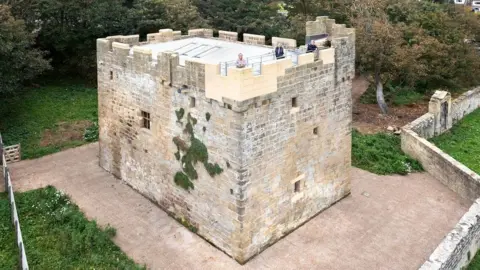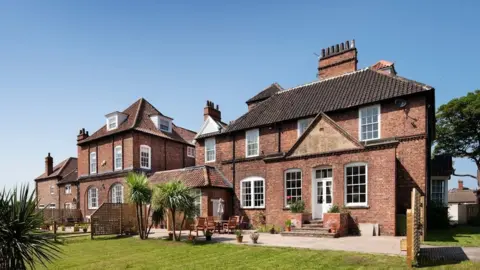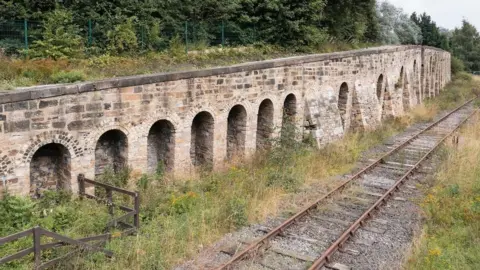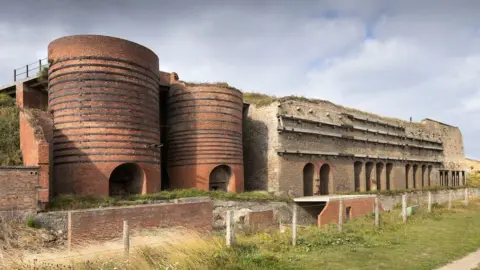Historic England: Cresswell Tower and lime kilns saved
 Historic England
Historic EnglandEighteen sites in the North East including a tower and lime kilns have been saved from being at risk of loss according to Historic England.
The conservation body said "hard work" had been done at the sites meaning they could be removed from the annually-updated at risk register.
Those "saved" include Cresswell Tower in Northumberland and the conservation area in Shildon, County Durham.
Meanwhile, six sites have been added to the register in 2021.
Historic England said they are "at risk of being lost forever as a result of neglect, decay or inappropriate development".
The six sites added to the list include:
- Washingwells Roman Fort, Whickham, Gateshead
- The Ringses camp, Doddington Moor, Northumberland
- A group of burial mounds and two cairns on Beanley Moor, Hedgeley, Northumberland
- A Romano-British enclosed settlement on Beanley Moor
- A Romano-British farmstead on Beanley Moor
- Park Level lead mine with ore works on Killhope Burn, Stanhope, County Durham
The example set by the 18 projects removed from the list should offer hope for the six new sites as well as the 253 other North East sites still on the register, a spokesman said.
Sites saved in 2021 include:
- Doxford House, Silksworth, Sunderland
- Hadrian's Wall from Cockmount Hill to Walltown, Greenhead, Northumberland
- Church of St Cuthbert, Ormesby, Redcar
- Medieval farmstead and irregular open field system at High Burntoft Farm, Elwick, Hartlepool
- Trimdon Village Conservation Area, County Durham
- Church of St Helen, Kelloe, County Durham
- Bowburn Conservation Area, Cassop-cum-Quarrington, County Durham
- Church of St Andrew, Dalton-le-Dale, County Durham
Trevor Mitchell, regional director for the North East and Yorkshire at Historic England, said: "Despite the challenges we have all faced recently, this year's Heritage at Risk Register shows that looking after our special places can contribute to the country's economic and social recovery, bring communities together and improve people's lives.
"The 18 sites saved this year in the North East show what's possible with strong partnerships, dedicated individuals and funding support."
Others saved include:
Cresswell Tower, Northumberland
 Historic England
Historic EnglandThe 14th Century Grade II*-listed tower was until recently, a roofless shell with a history of vandalism and graffiti.
It was built as a pele tower, a common feature in Northumberland between 1350 and 1600 to protect local families from border reivers.
A major restoration has been carried out by the tower's owners Parkdean Resorts along with Cresswell Parish Council and Historic England and it is now being run as a visitor attraction.

Red Barns, Redcar
 Historic England
Historic EnglandRed Barns house was designed for Redcar industrialist and philanthropist Hugh Bell by architect Phillip Webb between 1868 and 1870.
Bell's daughter Gertrude found fame as an archaeologist, writer and traveller who mapped Iraq and advised Winston Churchill during World War One.
Over the years the house was converted into a pub and hotel but suffered disrepair and vandalism when those businesses closed.
Its current owners have undertaken a major repair with the house set to re-open as a bed and breakfast in 2022.

Shildon Conservation Area, County Durham
 Historic England
Historic EnglandThe conservation area covers buildings and part of the intact route of the Stockton and Darlington Railway, said to be the railway that set the example for other networks when it opened in 1825.
Some of the listed buildings were at risk, Historic England said, but now its "future is bright" after £1.8m of repairs by Durham County Council and the Science Museum Group who run Locomotion rail museum which covers the conservation area.
Plans are also afoot to develop the museum ahead of the bicentenary of the railway's foundation in 2025.

Marsden Lime Kilns, South Shields
 Historic England
Historic EnglandThe 150-year-old kilns were built to produce lime for use in farming, construction and the steel and chemical industries and were operational until the 1960s, since when they have fallen into disrepair.
Its recent owners Owen Pugh have made efforts to stop further damage with work including the installation of timbers on the front of the kilns, Historic England said.
"The Marsden Lime Kilns are a rare survival, now in robust condition, thanks to the work of the team at Owen Pugh," a spokesman said.

Follow BBC North East & Cumbria on Twitter, Facebook and Instagram. Send your story ideas to [email protected].
